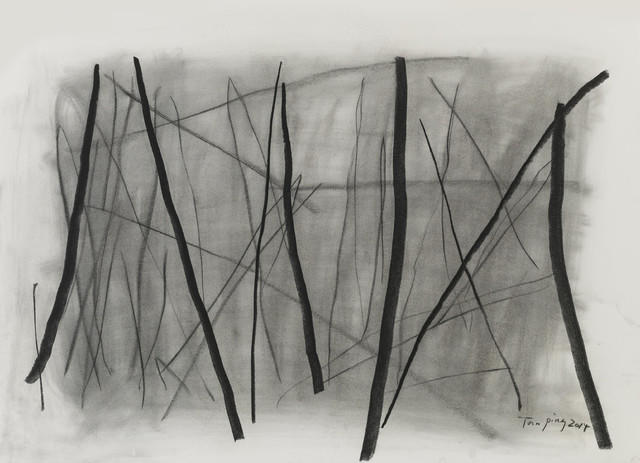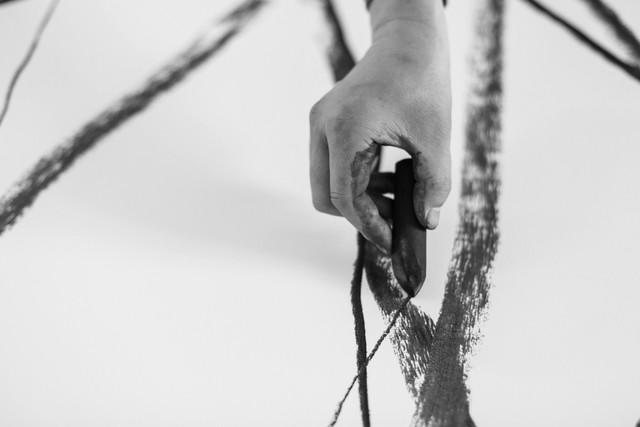
素描/炭笔/78.7×109.2cm/2014
第一次参观谭平工作室时,我惊讶地发现他在一张平坦的大桌面上创作素描,而绘画作品则在画架上完成。这两种完全不同的工作方式或许不应该令我惊讶,但因在参观其工作室之前,我一直将谭平的创作归类于西方传统和文脉中的抽象艺术,在我的想象中他的绘画是在平面上进行,而素描应该是在画架上完成。这个意外的发现促使我思考他创作所采用的全部方法和他所选方法的动因,以及这些方法对于他作品的意义。同时我还发现谭平的素描作品使用木炭条创作,仅有纯粹的黑白两色且多是不大的尺幅;而其绘画作品则大多色彩强烈且尺幅差异很大。并且尽管谭平的绘画与其素描一样都带有线的元素,但绘画中强烈的色彩显然凌驾于线条之上。恰如马克·罗斯科(Mark Rothko)的绘画,谭平的色彩在画布空间中流动,给予观者一种视觉体验,所有的色彩形态似乎都暂时跳脱了物质层面的局限,达到了形而上的境界。然而,那些素描作品则呈现出强烈的线性特征,层层叠叠的线条界定了边界和区块,如同从空中鸟瞰一条条层叠纵横交错的车道与繁忙的交通,充满了强烈的运动感与方向感。与绘画作品相反,这些素描呈现出非常夸张的、强烈而且形而下的物理属性,强化了某种与作品被创作的过程直接相呼应的身体感知。我知道谭平被称作是一位中国抽象艺术家。作为一个西方人,在目睹了他的创作方式之后,我此时第一次自问,应该如何定义一位中国抽象画家?当然,我也知道抽象艺术在中国并不热门,社会现实主义与学院派绘画的历史与影响力长期占有重要地位,即便现今,乌托邦社会主义、俄罗斯结构主义艺术家们,如:罗德琴科(Rodchenko),其前卫作品在俄罗斯和中国仍不被接受。然而,如何定义中国抽象画家这个问题却依然不容忽视。
对我来说,西方一般意义上所指的抽象艺术源于欧洲,特别是法国。然而,抽象表现主义中的非具象艺术(non-figurative art)、非客观艺术(nonobjective art)和非写实艺术(nonrepresentational)等确实起源于美国,如: 美国艺术家杰克逊·波洛克(Jackson Pollock)被尊称为这场艺术运动的鼻祖。大多数人认为杰克逊·波洛克是美国最重要的抽象表现主义画家,他作品的风格中特别值得一提的是滴画或行为绘画。波洛克说:“我的绘画并非在画架上完成”,它们其实是在地板上完成的,画布直接平铺在地板上,然后把颜料滴落、泼洒、喷溅在上面。波洛克放弃使用画架,把传统的调色盘换成装满颜料的桶,用木棒代替了画笔 ——当时,这是彻底地背离具象绘画传统的激进之举。具象绘画的目标是将客体、某事或某人现实地呈现,而波洛克抛弃了画架的垂直性,他将自己置于画作中心,让观者感受他内心个人化的表达和过程。绘画的过程成为了主体,作品反而是艺术表现的记录。波洛克常常称他好像看到自己在画里,他也确实站在自己作品的精神世界的中心。波洛克对其作品众多的注解中,他提到了美国纳瓦霍族原住民(Native Navajo Americans)的沙画技巧和过程,用沙子在地上绘画的神秘艺术形式与西藏僧侣们的坛城沙画技巧如出一辙。
美国艺术评论家克莱门特·格林伯格(Clement Greenberg)在波洛克的作品中看到了一种与以往完全不同的、全新的绘画形式,因其独特的美式风格而强烈推荐。格林伯格反驳了其风格参照超现实主义流派中自动主义的论点,因为其源于法国而不是美国,格林伯格认为波洛克的作品表达了美国的自由和个性精神。马克·托比(Marc Toby)在这一时期的创作中参考了中国书法,也许他是唯一一位公开谈论此事的艺术家。众所周知,美国这一时期的抽象绘画表达了强烈的国家认同感,因此也被拿来作为这一时期(冷战时期)的政治工具。杰克逊·波洛克这位狂野牛仔酒醉中因车祸丧生,接着有演员步其后尘,进一步宣传与波洛克相似的美国神秘形象,因主演电影《无因的反叛》(Rebel Without a Cause)而成为一代偶像的詹姆斯·迪恩(James Dean)也因高速车祸死在保时捷中。直至新表现主义艺术家让·米榭·巴斯奎恩(Jean-Michel Basquiat)因吸毒过量而死,这些叛逆的美国艺术家的神秘形象已经成为一个被持续关注的主题。
然而,这样的形象与谭平作品所表现出的感觉并不相符。谭平作为一位艺术家,其作品并非基于美国艺术家的神话或是美国抽象艺术的辩论术,而是一种迥然不同的冥想和反思的方式。
在谭平最新的展览中,他的纸上素描第一次摆在不同高度的展台上展出,其中六十厘米高度的展台让观者可以体验艺术家作画时的视角。观者自由穿行于素描的迷宫,探索画面在各种不同高度和视角下的转变,而这些视角无一不在揭示创作的过程。这并非谭平第一次以一种创新的方式来展示作品,他曾经在中国美术馆个展上展出过一根40米长,只有一根粗旷线条的版画作品。而在此次展览中,将素描作品置于通常用于展示雕塑的展台上,谭平再次强化其作品中形而下特征。与此同时,他用这种方式呈现作品也高度回应了中国画与中国书法在水平面上进行创作的传统,在水平面上创作的传统中,自然的重力和人的运力扮演了重要的角色。在记录谭平素描创作的视频中,可以看到在他作画的某一瞬间炭笔破碎,碎片掉到了他正在作画的纸上。我们看到了运动的规律性和连续性,他的手随心所欲地控制着压力和强度,在纸面上匀速而有规律地移动着。这既不是波洛克在画布上的疯狂移动和起舞,也不是罗伯特·莱曼(Robert Ryman)尝试用蜡笔画一条完美直线时的过程艺术流派的机械运动。这是完全不同的创作方式。
多年前当我第一次在中国的大街上看到有人拿着大毛笔沾水往地上写字时,我曾感到相当困惑,他们是在表演还是在练习?这是在做什么?我的第一反应是,不管这是什么,看他们认认真真写了半天到最后却不留一点痕迹,实在是一件极有意思的事情。直到后来我了解到,他们既是炫耀自己的才艺,也是在练习。每当我看到有人这样写书法时,我总是会驻足观看,希望有机会邂逅一位书法大师。我知道他们的手势体现出他们多年的练习和数千年高度结构化系统下的一种传统。谭平不是一位书法艺术家,但他的手势也体现出他多年的练习和这种传统的精髓,我相信其中的区别是他用自己的视觉语言重新构建和定义了“传统”。谭平常被人称为色彩大师,然而对我来说,他也是一个扎根于中国传统、具有高度视觉构建能力、追求丰富艺术创作过程的大师。

彳亍:谭平作品展/亚利桑那州立大学美术馆/美国/2015
The first time I visited Tan Ping’s studio I was surprised to discover that he drew his drawings flat on a table and the paintings were painted on an easel. I know this is perhaps not very surprising but it was for me as I thought it would be the other way around, because before this studio visit I had seen Tan Ping’s works and viewed them as abstract art that I placed primarily in a Western tradition and context. This made me think about the way he makes his work in general and why he made the choices he does and what they mean about his work. Other than being struck by this I also discovered the drawings were all black and white and all the same size, made with charcoal and the paintings always used color and differed wildly in size. The paintings even though had a strong linear element like the drawings the linear element was overridden by the importance of color. Like the paintings of Mark Rothko Tan Ping’s colors float spatially giving an optical experience such that the shapes of color evoke an ephemeral non physical quality to the extent of being metaphysical. In the drawings however, they are dominated by strong linear quality with overlapping lines that define boundaries and zones almost like looking from a bird’s eye view, viewing an auto route from above with all the different levels of roads and passages overlapping and intersecting and like the auto route giving a strong feeling of movement and direction. Unlike the paintings the drawings have a very strong and defiant physical and material sense about them that reinforces a physical almost corporal sense that corresponds directly to the process of their being made. I knew Tan Ping is referred to as an abstract Chinese artists so on this occasion for the first time I found myself as a Westerner asking, what does it mean to be described as a Chinese abstract painter. Of course I am aware that abstraction in China was not embraced to say the least and the influence and historical precedence of social realism and academic painting in China dominated until recently to the extent even the avant-garde works such as the utopian socialist Russian constructivist works of artists such as Rodchenko were rejected in both Russia and China but the question remained what does it mean to be a Chinese abstract painter.
For me what is commonly referred to abstract art in the West has its roots in Europe and particularly in France however, for me the term abstract expressionism as being nonfigurative art, nonobjective art, and nonrepresentational is strictly American in origin, with an artist such as Jackson Pollock being regarded as the grand farther of this movement. As most people consider Jackson Pollock to be the most important American abstract expressionist painter of this movement, with his style being specially referred to as drip or action painting. Pollock said;”My painting does not come from the easel”, in fact it came from the floor as he placed the canvas directly on the floor and; dripped, poured and splashed paint onto it. Jackson Pollok’s abandoning the easel and trading in the traditional palette for buckets full of paint and sticks that he used instead of brushes; at the time doing this was seen as a clear radical step away from the tradition of representational painting. Representational painting is goal oriented with the objective to realistically represent something or somebody, what Pollock did by abandoning the verticality of easel and representational painting was to place himself as the subject object in the center of the art work, leaving the spectator to experience the residue of his inner individualistic expression and process. The process of making the painting became the subject and conversely the painting a record of the artistic expression, Pollock would often state he saw himself as being inside his paintings he literally was; in the center of his inner universe of his artistic production. In one of the few references he made about his work Pollock refers to the technique and process of sand painting used by Native Navaho Americans, a technique of using sand to draw on the ground, a mystical art making practice, which is interestingly the same technique used by Tibetan Monks.
Clement Greenberg the American art critic saw in Pollock’s painting a new kind of painting that was distinctly different from anything before and he passionately promoted it as uniquely American. Greenberg rebutted any reference made to automatism from the surrealistic school of painting as it was French not American in origin, for Greenberg Pollock’s style embodied the American spirit of freedom of expression and individuality. Marc Toby’s paintings are probably the only artists of this period that had any reference made to Chinese calligraphy, probably because he the artist was the only person who spoke openly about it. As is well known today American abstract painting of this time was used to support a strong nationalist identity and consequently a political tool to support the political agenda of this period (the cold war). Jackson Pollock the wild individualistic cowboy who was killed in a car crash while drunk and later like the actor to follow in his footsteps and further propagate the same American mythical image as Pollock, James Dean the main actor in his most celebrated film a ‘Rebel Without a Cause’ would also die in his Porsche in a high speed car crash. The mythical image of these American artists as rebel has become an ongoing theme all the way to the Neo-expressionist Jean Michel Basquiat’s drug over dose.
This image does not correspond to the sensibility of Tan Ping’s work. Tan Ping as an artist and in his work as they are not rooted in either the American artist’s myth or the polemics surrounding American Abstract painting but is of a very different more contemplative and reflexive manner than the later.
In Tan Ping ‘s latest exhibitions for the first time his black and white paper drawings are presented on pedestal giving the spectator the same vantage point as the artist when the drawings were made. The spectator can freely walk through this maze of drawings, discovering the shifting visual elevations in the drawings, with each drawing’s elevation reveals the process of its making; lines drawn and then whipped away to leave; traces, residue, phantom lines turned into gray zones. Tan Ping’s decision to present his work in an innovative way is not new for this artist, as he had presented a bold single line 40 meters long print for his personnel exhibition at the National Museum. In choosing to mount his drawings on the pedestals which are usually reserved to the domain of sculpture, he has conceptually and visually confirmed the physicality of the drawings. Concurrently, presenting the works in this manner strongly acknowledges the Chinese traditions of drawing horizontally as it does with the tradition of ink calligraphy drawing, a tradition were the use of gravity and force play an important role. In the documentary video of Tan Pings drawing we see charcoal sticks fracture and shards of the stick shatter off falling onto the paper as he draws. We see the regularity and consistency of movement, his hand moving at the same even regular strong speed with his controlling the pressure and force varying it as he desires. This is not Jackson Pollock frenetically moving and dancing in the middle of his canvas, neither is it the mechanical movements of the Process Art of Robert Ryman paintings where he tries to paint a perfectly straight line with encaustic paint, it is something else.
When I first saw calligraphy painting on the street painting with water I was totally bemused. Were they doing a performance were they practicing what was this all about? My first reaction was whatever it is it is very interesting to see an act of painting that left nothing behind. I was to learn it was a combination of both showing off their skill and practicing. When I see these painters I always stop to watch as I do if I have the chance to see a master calligraphic artist. I understand their gestures embody year of practice and hundreds of years of tradition of a highly structured system. Tan Ping does not make calligraphy but his gestures embody years of practice and relate to hundreds of years of a highly structured system but I believe the difference is he has recreated and redefined this system into his own visual language. Tan Ping is often referred to as a master of color but for me he is also a master of a highly organized visually rich process of art making rooted in a Chinese tradition.

摄影:见涛
